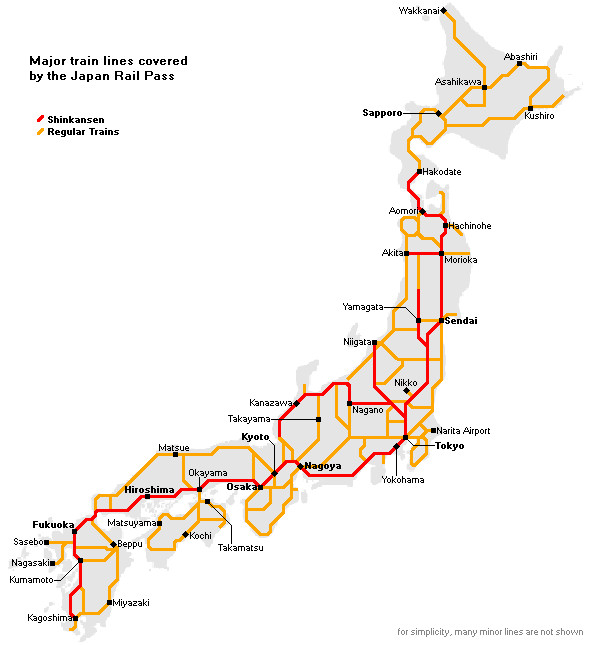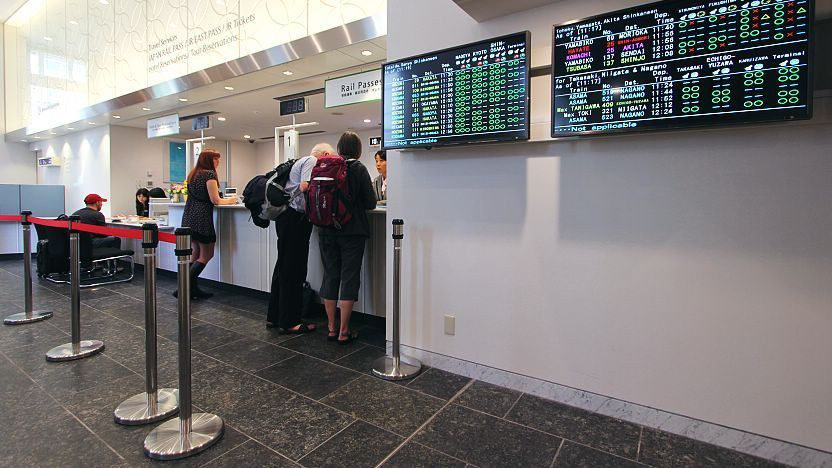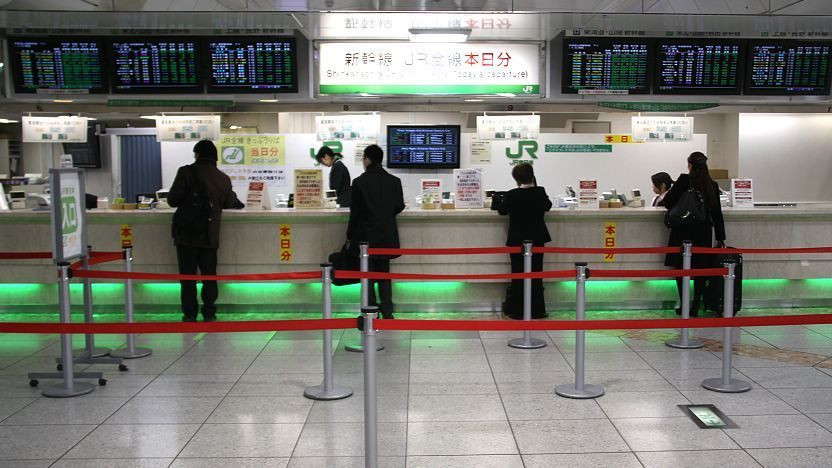Planning a trip to Japan? Is the Japan Travel Jr Pass the key to unlocking seamless and affordable travel across the country? SIXT.VN offers expert insights to help you decide if this pass is the perfect fit for your Japanese adventure. Discover the benefits, potential drawbacks, and how to maximize its value for an unforgettable travel experience. Consider SIXT.VN for convenient airport transfers, comfortable hotel bookings, and curated tour packages that complement your rail journey.
1. What is the Japan Travel JR Pass and How Does It Work?
The Japan Travel JR Pass, or Japan Rail Pass, is a special ticket that allows foreign tourists to travel on most Japan Railways (JR) trains throughout Japan for a fixed period. It offers unlimited rides, making it a potentially cost-effective and convenient way to explore the country.
The Japan Rail Pass is essentially an all-you-can-ride ticket for JR trains. It’s designed for tourists visiting Japan for sightseeing and is valid for 7, 14, or 21 consecutive days. With this pass, you can access almost all JR national trains, including Shinkansen bullet trains (with some exceptions), limited express trains, local trains, JR buses, and even the JR ferry to Miyajima. However, it’s crucial to note that the pass does not cover travel on the Nozomi and Mizuho Shinkansen trains on the Tokaido, Sanyo, and Kyushu Shinkansen lines without paying extra. The pass is available in two classes: Ordinary and Green Car (first class), offering options for different comfort levels. According to the Japan National Tourism Organization (JNTO), the JR Pass can significantly reduce travel costs for tourists planning extensive travel across Japan.
 Japan Rail Pass Map
Japan Rail Pass Map
Japan Rail Pass Route Map
2. Who is Eligible to Use the Japan Travel JR Pass?
The Japan Travel JR Pass is exclusively for foreign tourists visiting Japan under a “temporary visitor” visa status. It is also available to Japanese nationals living abroad for at least ten years.
To be eligible for the Japan Travel JR Pass, you must meet specific criteria. Firstly, you must be a foreign tourist visiting Japan for sightseeing purposes with a “temporary visitor” visa. This visa is typically stamped in your passport upon arrival. Secondly, Japanese nationals who have lived permanently outside Japan for ten or more years are also eligible, but they must provide proof of their long-term residency abroad. The Japan Rail Pass cannot be used by residents of Japan, even if they hold foreign passports. According to the official Japan Rail Pass website, these eligibility rules are strictly enforced to ensure the pass benefits international tourists and returning Japanese citizens who have spent a significant time abroad.
3. What Types of Japan Travel JR Passes Are Available and How Much Do They Cost?
The Japan Travel JR Pass comes in two types: Ordinary and Green Car (first class), each available for 7, 14, or 21 consecutive days. Prices vary depending on the duration and class.
Here’s a breakdown of the Japan Rail Pass types and costs:
| Type | Ordinary (7 Days) | Ordinary (14 Days) | Ordinary (21 Days) | Green Car (7 Days) | Green Car (14 Days) | Green Car (21 Days) |
|---|---|---|---|---|---|---|
| Price (approx. in Yen) | 50,000 | 80,000 | 100,000 | 70,000 | 110,000 | 140,000 |
Children aged 6-11 receive a 50% discount. Please note that prices are subject to change, and it’s always best to check the official Japan Rail Pass website or authorized vendors for the most up-to-date information.
4. What are the Benefits of Buying a Japan Travel JR Pass?
The Japan Travel JR Pass offers unlimited travel on most JR trains, free seat reservations, and discounts at some tourist attractions, providing convenience and potential cost savings for extensive travel.
The key advantages of the Japan Rail Pass are:
- Unlimited Travel: The pass allows unlimited rides on most JR trains, which is ideal for those planning to visit multiple cities.
- Cost Savings: For long-distance travel, the pass can be more economical than purchasing individual tickets.
- Convenience: The pass simplifies travel, eliminating the need to buy tickets for each journey.
- Free Seat Reservations: Pass holders can reserve seats on many JR trains at no additional cost.
- Discounts: Some tourist sites and services offer discounts to JR Pass holders.
According to a study by the Japan Tourism Agency, approximately 70% of foreign tourists who purchased the JR Pass found it to be a valuable asset for their travel plans, citing convenience and cost-effectiveness as the primary reasons.
5. What are the Limitations and Restrictions of the Japan Travel JR Pass?
The Japan Travel JR Pass has limitations, including restrictions on certain Shinkansen trains, validity periods, and usage by non-eligible individuals. It’s not valid on Nozomi and Mizuho Shinkansen trains without extra fees.
Here are the key limitations and restrictions to consider:
- Nozomi and Mizuho Trains: The pass is not valid on the fastest Shinkansen trains, Nozomi and Mizuho, without paying a supplement fee.
- Validity Period: The pass is valid for consecutive days only (7, 14, or 21 days), so you need to plan your travel accordingly.
- Eligibility: The pass is strictly for temporary visitors and eligible Japanese nationals residing abroad.
- Limited Use in Cities: While useful, the pass may not cover all transportation within cities, as some local trains and subways are not JR lines.
- Non-Transferable: The pass is personal and cannot be shared or transferred to another person.
According to JR Central, one of the major JR companies, these restrictions are in place to maintain service quality and manage passenger flow effectively.
6. How Do I Purchase a Japan Travel JR Pass?
You can purchase a Japan Travel JR Pass online through authorized vendors or travel agencies before arriving in Japan. You’ll receive an exchange order, which you’ll need to exchange for the actual pass upon arrival.
The process for purchasing a Japan Rail Pass involves these steps:
- Purchase an Exchange Order: Buy the pass online from an authorized vendor like SIXT.VN or a travel agency before you travel to Japan. You’ll receive an exchange order (voucher).
- Exchange the Voucher: Upon arrival in Japan, take your exchange order and passport to a designated JR exchange office. These offices are typically located at major airports and train stations.
- Activate Your Pass: At the exchange office, you’ll specify the date you want your pass to become active. The validity period (7, 14, or 21 days) starts on that date.
It’s important to note that you cannot purchase the Japan Rail Pass directly within Japan anymore, except under specific limited circumstances. According to the official Japan Rail Pass website, purchasing in advance is essential for most travelers.
 Rail Pass Exchange Counter at Tokyo Station
Rail Pass Exchange Counter at Tokyo Station
Rail pass exchange counter at Tokyo Station
7. How Do I Activate and Use the Japan Travel JR Pass?
To activate your Japan Travel JR Pass, exchange your voucher for the actual pass at a JR exchange office in Japan. To use it, simply show the pass to the JR staff at the ticket gate or use the automatic gates.
Here’s how to activate and use your JR Pass:
- Exchange Your Voucher: Upon arrival in Japan, go to a designated JR exchange office, usually located at major airports or train stations. Present your exchange order and passport to the staff.
- Specify Activation Date: Choose the date you want your pass to become active. The validity period starts on this date, so plan accordingly.
- Receive Your Pass: The staff will issue your Japan Rail Pass.
- Using the Pass: To use the pass, either show it to the JR staff at the manned ticket gate or use the automatic ticket gates (as of June 2020). If you have a reserved seat, show your pass and seat reservation ticket.
According to JR East, using the automatic ticket gates has significantly reduced wait times for pass holders, making travel more efficient.
8. Can I Make Seat Reservations with the Japan Travel JR Pass?
Yes, Japan Travel JR Pass holders can make seat reservations for free on most JR trains. Reservations can be made at ticket machines, ticket offices, or online for passes purchased through the official website.
Seat reservations are a valuable benefit of the Japan Rail Pass. Here’s what you need to know:
- How to Reserve: You can make seat reservations at JR ticket offices (Midori-no-madoguchi) or at designated ticket machines. If you purchased your pass through the official website, you can also make online reservations.
- Cost: Seat reservations are free for JR Pass holders.
- When to Reserve: It’s recommended to make reservations during peak travel seasons or for popular routes to ensure you get a seat.
- Mandatory Reservations: Some trains, like the Narita Express and certain limited express trains, require seat reservations.
According to JR Kyushu, seat reservations are especially recommended during holidays like Golden Week, Obon, and the New Year period.
 Seat reservations can be made at any JR ticket counter across Japan
Seat reservations can be made at any JR ticket counter across Japan
Seat reservations can be made at any JR ticket counter across Japan
9. What Happens if I Lose My Japan Travel JR Pass?
If you lose your Japan Travel JR Pass, it cannot be reissued or replaced. Treat it like cash and keep it safe.
Unfortunately, the Japan Rail Pass is like cash: if it’s lost or stolen, it cannot be replaced or reissued. JR does not offer any refunds or replacements for lost passes. To avoid this situation, keep your pass in a safe and secure place. It’s also a good idea to have a photocopy of your pass in case you need it for any administrative purposes.
10. Is the Japan Travel JR Pass Worth the Cost?
The Japan Travel JR Pass is worth the cost if you plan to travel extensively across Japan, especially on long-distance routes. However, it may not be cost-effective for those who only plan to stay in one city or travel short distances.
To determine if the Japan Rail Pass is worth the investment, consider these factors:
- Travel Itinerary: If you plan to visit multiple cities and regions, the pass is likely to be cost-effective.
- Travel Style: If you prefer the convenience and flexibility of unlimited train travel, the pass can be a good choice.
- Cost Comparison: Calculate the cost of individual train tickets for your planned itinerary and compare it to the price of the pass.
- Time of Year: During peak travel seasons, the pass can help you avoid the hassle of purchasing individual tickets and ensure you have a seat.
According to travel experts, the JR Pass generally pays off if you plan to make at least one round trip between Tokyo and Kyoto or travel similar distances within the validity period of the pass.
11. What are Some Alternative Transportation Options in Japan?
Alternative transportation options in Japan include domestic flights, highway buses, local trains, and rental cars, each with its own advantages and disadvantages.
If the Japan Rail Pass doesn’t fit your travel needs, consider these alternatives:
- Domestic Flights: For long distances, domestic flights can be faster than trains, but they often involve airport transfers and security checks.
- Highway Buses: Highway buses are a more budget-friendly option, especially for overnight travel.
- Local Trains: Local trains are ideal for short distances and exploring specific regions.
- Rental Cars: Renting a car gives you flexibility and freedom, but driving in Japan can be challenging due to traffic and road conditions.
According to the Ministry of Land, Infrastructure, Transport and Tourism (MLIT), each mode of transport has its own advantages, and the best choice depends on your budget, time constraints, and travel preferences.
12. How Can I Maximize the Value of My Japan Travel JR Pass?
To maximize the value of your Japan Travel JR Pass, plan your itinerary carefully, utilize free seat reservations, and take advantage of discounts at tourist attractions.
Here are some tips for getting the most out of your JR Pass:
- Plan Your Itinerary: Create a detailed itinerary that includes long-distance travel to make the most of the pass.
- Utilize Seat Reservations: Reserve seats on popular trains, especially during peak seasons, to ensure a comfortable journey.
- Take Advantage of Discounts: Check for discounts at tourist sites and services that are available to JR Pass holders.
- Use JR Local Lines: Utilize JR local lines for shorter trips within cities to save on transportation costs.
- Activate Strategically: Choose the activation date carefully to align with your longest travel days.
According to experienced travelers, careful planning and strategic use of the JR Pass can result in significant cost savings and a more enjoyable travel experience.
13. What Should I Know About Train Etiquette in Japan?
Train etiquette in Japan emphasizes respect for fellow passengers, including being quiet, refraining from talking on the phone, and avoiding eating smelly foods.
When traveling on trains in Japan, keep these etiquette tips in mind:
- Be Quiet: Keep your voice down and avoid loud conversations.
- No Phone Calls: Refrain from talking on your phone; use text messaging instead.
- Respect Seating: Offer your seat to elderly, pregnant, or disabled passengers.
- Avoid Smelly Foods: Be mindful of strong-smelling foods that may disturb other passengers.
- Keep Clean: Avoid littering and keep your area clean.
- Line Up: When boarding, line up and wait your turn.
- No Blocking: Avoid blocking aisles or doorways with your luggage.
According to Japanese culture experts, these etiquette practices reflect the importance of harmony and consideration for others in public spaces.
 Railway station late at night
Railway station late at night
Railway station late at night
14. What are Some Popular Destinations Accessible with the Japan Travel JR Pass?
Popular destinations accessible with the Japan Travel JR Pass include Tokyo, Kyoto, Osaka, Hiroshima, and Sapporo, offering a diverse range of cultural and historical experiences.
With the Japan Rail Pass, you can easily access these popular destinations:
- Tokyo: Explore the vibrant capital city, including its modern skyscrapers, historic temples, and bustling shopping districts.
- Kyoto: Discover traditional Japanese culture, with its beautiful gardens, ancient temples, and geisha districts.
- Osaka: Experience the lively food scene and visit iconic landmarks like Osaka Castle.
- Hiroshima: Reflect on history at the Hiroshima Peace Memorial Park and visit the beautiful Miyajima Island with its iconic floating torii gate.
- Sapporo: Enjoy the winter wonderland of Sapporo, known for its snow festival and delicious seafood.
According to the Japan National Tourism Organization (JNTO), these destinations offer a diverse range of experiences that showcase the best of Japan.
15. How Does the Japan Travel JR Pass Compare to Regional Rail Passes?
The Japan Travel JR Pass covers the entire country, while regional rail passes offer more focused coverage and may be more cost-effective for exploring specific areas.
When considering rail passes, it’s important to understand the differences between the nationwide Japan Rail Pass and regional passes:
| Feature | Japan Rail Pass | Regional Rail Passes |
|---|---|---|
| Coverage | Entire country | Specific regions (e.g., JR East, JR West) |
| Validity | 7, 14, or 21 consecutive days | Varies by pass (e.g., 5 days within 14 days) |
| Cost | Higher | Lower |
| Best For | Extensive travel across multiple regions | Focused exploration of a specific region |
| Example Regions | N/A | Kansai, Hokkaido, Kyushu |
According to rail travel experts, regional passes can be a better value if you’re primarily interested in exploring a particular area of Japan.
16. What is the Difference Between Ordinary and Green Car Japan Travel JR Passes?
The Ordinary Japan Travel JR Pass provides standard seating, while the Green Car pass offers access to first-class cars with more spacious seats and enhanced amenities.
The key difference between the Ordinary and Green Car Japan Rail Pass is the level of comfort and service:
- Ordinary Car: Provides access to standard seating on JR trains.
- Green Car: Offers access to first-class cars with larger seats, more legroom, and enhanced amenities. Green cars tend to be less crowded than ordinary cars.
Many travelers find the ordinary seats sufficient, but those looking for additional luxury may prefer the Green Car pass. According to JR train operators, Green Cars are available on most Shinkansen and limited express trains, as well as a small number of local trains.
 Ordinary car (left) and Green Car (right)
Ordinary car (left) and Green Car (right)
Ordinary car (left) and Green Car (right)
17. Can I Upgrade to Green Car with an Ordinary Japan Travel JR Pass?
While it’s possible to upgrade to Green Car with an Ordinary Japan Travel JR Pass, you’ll need to pay the additional fees for the Green Car and any applicable express supplements.
If you have an Ordinary Japan Rail Pass and want to ride in a Green Car, you can do so by paying the difference between the ordinary fare and the Green Car fare, as well as any applicable express or limited express surcharges. However, this can be quite expensive, especially on long-distance Shinkansen routes. In most cases, it’s more cost-effective to purchase the Green Car pass upfront if you plan to use Green Cars frequently.
18. What are the Peak Travel Seasons in Japan and How Do They Affect JR Pass Usage?
Peak travel seasons in Japan include New Year, Golden Week, and Obon, during which trains are crowded and seat reservations are highly recommended for Japan Travel JR Pass holders.
The peak travel seasons in Japan are:
- New Year (late December to early January): Many Japanese people travel to visit family, resulting in crowded trains and stations.
- Golden Week (late April to early May): A series of national holidays create a week of heavy travel.
- Obon (mid-August): A Buddhist holiday when many people return to their hometowns.
During these periods, it’s essential to book seat reservations well in advance, as trains can fill up quickly. According to JR, some trains, like the Nozomi Shinkansen during peak seasons, may require mandatory seat reservations.
19. What Happens if My Japan Travel JR Pass Expires While I’m on a Train?
If your Japan Travel JR Pass expires while you’re on a train, it remains valid until the end of your journey, but you may need to pay extra for any travel beyond the expiration.
If your Japan Rail Pass expires at midnight while you’re on a train, the pass remains valid until you reach your final destination. This includes transfers to other trains, as long as you don’t exit the station. However, if you transfer to a Shinkansen or limited express train after midnight, you’ll need to pay the express supplement for that train. It’s always a good idea to plan your travel to minimize the risk of your pass expiring mid-journey.
20. How Can SIXT.VN Help Me Plan My Japan Trip with the JR Pass?
SIXT.VN offers comprehensive travel services, including JR Pass purchase assistance, airport transfers, hotel bookings, and curated tour packages, to ensure a seamless and unforgettable Japan experience.
SIXT.VN can assist you with every aspect of your Japan trip, including:
- JR Pass Purchase: Purchase your Japan Rail Pass through SIXT.VN, an authorized vendor.
- Airport Transfers: Arrange convenient airport transfers to your hotel.
- Hotel Bookings: Book accommodations in major cities and tourist destinations.
- Tour Packages: Choose from curated tour packages that complement your rail journey.
- Travel Advice: Receive expert advice on planning your itinerary and maximizing the value of your JR Pass.
With SIXT.VN, you can enjoy a hassle-free and unforgettable travel experience in Japan. Let SIXT.VN handle the details so you can focus on exploring the beauty and culture of Japan. Contact us today to start planning your dream trip!
Address: 260 Cau Giay, Hanoi, Vietnam
Hotline/Whatsapp: +84 986 244 358
Website: SIXT.VN
FAQ: Japan Travel JR Pass
1. Can foreign residents of Japan use the JR Pass?
No, the Japan Travel JR Pass is exclusively for tourists with a “temporary visitor” visa or Japanese nationals residing abroad for over ten years.
2. Is it possible to buy a JR Pass after arriving in Japan?
Purchasing the JR Pass inside Japan is no longer widely available. It’s best to buy an exchange order before your trip.
3. How far in advance should I purchase my JR Pass?
It’s recommended to purchase your JR Pass exchange order at least a few weeks before your trip to allow time for shipping and processing.
4. Can I use the JR Pass on all Shinkansen bullet trains?
No, the JR Pass is not valid on the Nozomi and Mizuho Shinkansen trains without paying an additional fee.
5. Are seat reservations required for all JR trains?
Seat reservations are not mandatory on most JR trains, but they are highly recommended during peak travel seasons and for certain trains.
6. What happens if I miss my reserved train with a JR Pass?
If you miss your reserved train, you can try to cancel your reservation and make a new one for a later departure.
7. Is the JR Pass valid on buses and ferries?
Yes, the JR Pass is valid on some JR buses and the JR ferry to Miyajima Island.
8. Can I get a refund for an unused JR Pass?
Refund policies vary depending on the vendor. Check the terms and conditions before purchasing your pass.
9. Does the JR Pass cover transportation within cities like Tokyo and Osaka?
The JR Pass can be useful for transportation on JR lines within cities, but it does not cover non-JR subways and buses.
10. Is it better to get a regional pass or a Japan Rail Pass?
A regional pass may be more cost-effective if you plan to focus your travel on a specific area of Japan. The Japan Rail Pass is better for extensive travel across multiple regions.



